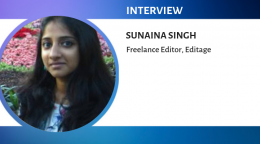AI and the future of peer review: An interview with Maryam Sayab

"Balancing proactive planning, continuous learning and collaboration can help us stay ahead of the curve and assure that peer review evolves in a way that benefits everyone involved." - Maryam Sayab
We are happy to have with us Maryam Sayab, who is also Co-Chair for the Peer Review Week committee, 2024.
Maryam Sayab serves as the Director of Communication at the Asian Council of Science Editors, a leading organization dedicated to advancing scholarly publishing across Asia. She also holds key roles as an Ambassador for the Center for Open Science and as Co-Chair of the Peer Review Week Committee. With nine years of experience in scholarly communication and publishing, Maryam brings expertise in science communication, strategic planning, policy development, editorial work, on-demand training, and project management. Her commitment to enhancing the quality and accessibility of scientific research continues to shape the future of academic publishing in the region.
We asked her to share her thoughts about the role of technology in the changing landscape of peer review. She shares some wonderful insights into pros and cons of integrating technology into the peer review workflow.
Read on for more of her insights into innvative technologies and their role in peer review:
What are the most promising technological advancements in peer review, and how do you see them shaping the future?
The technological advancements that excite me the most in peer review are AI-driven tools. These tools are transforming the peer review process. For example, one can quickly identify potential cases of plagiarism or image manipulation. Looking to the future, I see these tools becoming indispensable, as they will speed up the process and enhance the overall quality of peer review.
With the rise of AI-driven tools in peer review, how can we ensure that the integrity of the review process is maintained?
To ensure integrity, we need a robust process in which AI could handle the routine, time-consuming tasks. This would allow humans to freely focus on the deeper aspects of the review. While AI can suggest possible issues, the final decision should always rest with humans. The human reviewer can evaluate the context and make informed judgments. This is a hybrid approach which leverages the efficiency of AI while retaining the irreplaceable insight of human reviewers. I believe this will help us to maintain high standards of peer review in an increasingly digital world.
What measures should be taken to balance human judgment with technological assistance in peer review?
A practical approach to balancing human judgment with technological assistance in peer review is:
- To let AI handle the initial, routine tasks, such as checking for plagiarism, flagging image manipulation, or suggesting potential conflicts of interest.
- To let human reviewers handle deeper, more subjective evaluations, such as assessing the significance of a study or the quality of its methodology.
A combination of AI with the insight and expertise of human reviewers can streamline the process and ensure that the final judgment is thorough and thoughtful. This hybrid approach not only enhances the quality of peer review but also allows editors and reviewers to focus their energy where it truly matters.
What are the main challenges or barriers to the adoption of new technologies in peer review?
- One of the biggest challenges in adopting new technologies in peer review is the natural hesitancy and resistance to change.
- New technology costs time and money which requires the continuous support from institutions so that reviewers feel at ease.
- There are concerns about whether AI tools are reliable and can truly be trusted to not compromise the quality and integrity of the review.
Addressing these concerns requires not only demonstrating the effectiveness of these technologies but also ensuring they are used to complement, rather than replace, human judgment.
How can institutions and publishers support reviewers and editors in adapting to these technological changes?
Supporting editors and reviewers is a must to survive in this digital transformation. Institutions and publishers can provide their support by:
- offering training programs
- providing ongoing technical support
- encouraging adoption of new tools
- involve reviewers in development and testing of technologies.
How can the academic community address the skepticism or resistance some may have toward integrating technology into peer review?
Addressing skepticism or resistance to integrating technology into peer review requires a thoughtful and inclusive approach by the academic community. This includes:
- Educating reviewers on the benefits of technology, such as enhanced efficiency, transparency, and fairness.
- Acknowledging concerns and to reassure stakeholders that technology complements rather than replaces human judgment.
- Gradual implementation of technology, starting with simpler tools and progressively introducing more advanced systems to ease the transition.
- Providing training and support to help boost confidence in using new tools.
- Maintaining transparency about how technology is used, to build trust.
- Engaging the community through continuous feedback and demonstrating responsiveness to their concerns.
Looking ahead, what trends in technology do you think will have the most significant impact on peer review over the next decade?
Over the next decade, a few technical developments will have the most significant impact on the peer review landscape.
- The incorporation of machine learning and artificial intelligence (AI): Although AI cannot replace human judgment, it may undoubtedly speed up and improve the process.
- The application of blockchain technology: By producing permanent records of the whole review process, this has the potential to increase transparency and accountability in peer review.
- A rise in collaborative platforms: These approaches encourage greater transparency by involving a wider range of voices in the review process, leading to more diverse and inclusive evaluations of research.
- Advancements in data analytics: are set to improve how we track and analyze peer review performance. This could help journals and publishers refine their processes for better outcomes.
Together, these trends will create a peer review system that is more efficient, transparent, and fair.
How can we prepare for the potential challenges and opportunities that these future trends might bring?
All it takes to get ready for the future of peer review technology is a flexible and open mind. It is imperative that the academic community adopt new tools and technology while remaining cognizant of possible drawbacks. This entails ensuring that everyone is at ease and confident while utilizing advancements like blockchain and artificial intelligence, in addition to teaching researchers, editors, and reviewers about their advantages. Having regular opportunities for training and growth can greatly aid us in effectively navigating these changes.
Of course, there are risks associated with every new technology. For example, bias concerns may arise with AI, and privacy concerns may arise with blockchain. We require precise norms and moral standards in order to address these problems head-on. It will be crucial for IT companies and publishers.
On the flip side, the opportunities are exciting, including:
- Transparency, efficiency and inclusivity
- Broader range of perspectives
- Fairer and more thorough evaluations.
- Data analytics can help us can keep improving the peer review process over time.
Balancing proactive planning, continuous learning and collaboration can help us stay ahead of the curve and assure that peer review evolves in a way that benefits everyone involved.
Comments
You're looking to give wings to your academic career and publication journey. We like that!
Why don't we give you complete access! Create a free account and get unlimited access to all resources & a vibrant researcher community.














